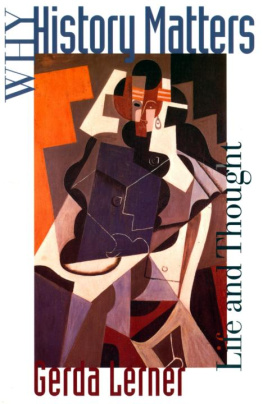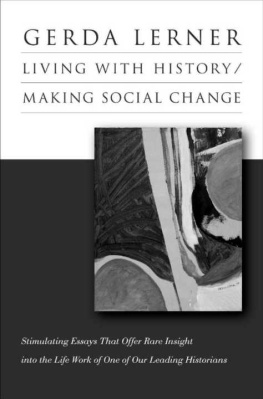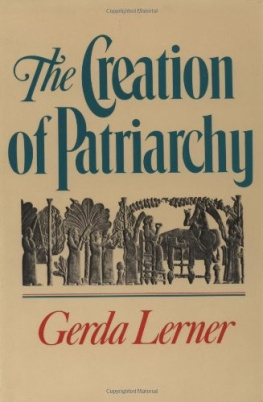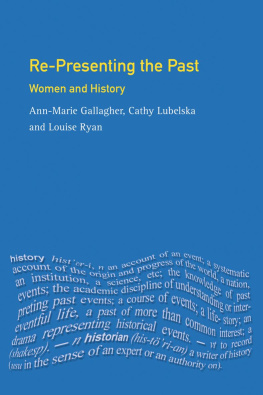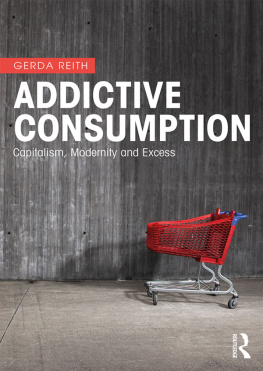1979 by Gerda Lerner
Foreword 2005 by The University of North Carolina Press
All rights reserved
Manufactured in the United States of America
Set in Bembo and Castellar by Tseng Information Systems, Inc.
The paper in this book meets the guidelines for permanence and durability of the Committee on Production Guidelines for Book Longevity of the Council on Library Resources.
The Library of Congress has cataloged the original
edition of this book as follows:
Lerner, Gerda, 1920
The majority finds its past.
Includes bibliographical references and index.
1. WomenUnited StatesHistory. 2. Afro-American
womenHistory 3. FeminismUnited StatesHistory.
4. Womens rightsUnited StatesHistory. I. Title.
HQ1426.L47 301.4120973 79-1404
ISBN 0-8078-5606-1 (pbk.: alk. paper)
09 08 07 06 05 5 4 3 2 1
Foreword
Nowadays, when feminist historians write prize-winning books that publishers are proud to produce, it is easy to forget that not very long ago, women wereas a colleague once observed to mea topic, not a subject. Gerda Lerner was not the first twentieth-century historian to embrace the history of women as a subjectbefore her there were Mary Beard, Constance McLaughlin Green, Eleanor Flexnernor was she the only historian of her generation to do so, but she has done more than most and arguably more than anyone to establish the history of women as a field of inquiry. Like other historians, since the 1960s she has been undertaking scrupulous research and writing lucid narratives; unlike historians in other fields, she had first to demand respect for her subject.
She did this most effectively in the essays that are collected here. Written in the period between the publication in 1963 of Betty Friedans The Feminine Mystique (to which many of these essays are a corrective, a friendly amendment) and the first years of President Jimmy Carters administration, Gerda Lerners careful refocusing of the distortions of history writing continue to clarify confusions and set an agenda that we still face. She perceived early on that womens history is less a separate subject than a way of thinking, a strategy by which to focus on... that which traditional history has obscured. It is a route by which we can bypass the habit of treating the history of women as anecdotal, merely a collection of missing facts and views. And more than anything else, it is an intellectual exercise, calling into question the claim to universality which History generally assumes as a given and identifying relationships of power that the powerful prefer to conceal.
Writing in a decade when feminists dreamed of sisterhood, Lerner shared the dream and worked hard in her daily life to structure the collective modes by which it could be realized. But she simultaneously judged it. Even the earliest essays in this book insist that it is too easy to assume that all women are sisters. Not all are oppressed in the same ways. Women differ in class, and they differ in race: the plantation mistress may be pressured by the patriarchal power of her father and her husband, but she herself is an oppressor of the slave. At a time when other analysts were identifying the antebellum cult of true womanhood as a device to weaken women, Lerner was clear-eyed enoughin the second essay in this bookto name the cult of the lady as itself a device to support class relations, enabling white and middle-class women to claim their superiority over working-class and nonwhite people and simultaneously justifying their own exclusion from equal education and from participation in the political process.
At a time when the American public was dazzled by Betty Friedans denunciation of the feminine mystiquethe insistence that women find their fulfillment in marriage, domesticity, and tasteful purchasing of consumer products for the suburban homeLerner shared much of the enthusiasm. She told Friedan privately that she had written a splendid book. But Lerner placed Friedans work in historical perspective, arguing that the mystique Friedan found in the 1950s was a new form of an old phenomenon, a compensatory ideology developed in the antebellum era of industrialization, now updated by consumerism and the misunderstood dicta of Freudian psychology. The problem, as Lerner saw it, was that Friedan had ignored the need for institutional solutions to the problems of women and had ignored how working women, especially Negro women, suffered from the more pressing disadvantages of economic discrimination. * In effect, the criticisms of American society made by The Feminine Mystique were themselves tangled in a romanticizationand denialof the power embedded in class and race relations. It is a common fallacy, Lerner would write a few years later, to proceed on the assumption that what is true for middle-class women is true for all women. And Lerner could be brutally clear-sighted: marriage and other sexual liaisons offer much more chance of upward mobility for the lower-class girl than does education. For them, the mystique worked.
By the end of the 1960s, Lerner had already begun to historicize the womens movement of her own time that emerged from the Old Left and the civil rights movements of the 1940s and 1950s. At a time when the media teased womens liberation, she offered the historical defense it badly needed, grounding it in the womens movement that had emerged from abolition more than a century before. But she also criticized Womens Liberation for its ahistorical and social naivete. When feminists claimed the universality and priority of sexual oppression as an experience common to all women, they might have constructed a useful agitational tool, but they did not have a tool that worked as a tool for historical analysis. When class relations were ignored, so were signs of the feminization of povertythe displacing onto women of the burdens of industrial society, partially measured in maternal and infant mortality rates. When race relations were ignored, so too was reality: Lerner could write of the female-headed black family as a reasonable response and a useful adaptation to the pervasive economic disempowerment of black men, grounded in African cultural tradition. But to speak of black femaleheaded families as black matriarchy in contemporary society is a cruel hoax, she wrote in 1973: Matriarchy, by definition, means power by women: decision-making power; power over their own lives; power over the lives of others; power in their communities. Throughout Lerner brings historical analysis and historical precedents to bear on the challenge of understanding policy decisions and political practices of our own time.
Yet just at the moment when Lerner has convinced the reader that the differences among women are so multiple that there can be nothing all women share, she catches us with lists of what they have had in common over the course of centuries: a history of educational deprivation, a different relationship to property than men have had, a vulnerability to sexual exploitation, topped off by a political marginalization that has denied them political representation and power in government. Lerner is hungry for sweeping generalizations, and occasionally the ones she proposes have not stood up well over timefor example, the assertion that womens status in the nineteenth century was considerably worse than in the colonial era now seems overly emphatic (but not without some truth, although historians are more likely to speak of patriarchy gaining strength at the beginning of the eighteenth century as well as, along different lines, in the nineteenth). Many of these generalizations, however, have even greater strength than Lerner could have predicted. When she wrote in the 1970s, for example, of sexual exploitation manifested in the rape of women of the conquered group by the victors... [and] in the millennia of organized prostitution, she had in mind events ranging in time from antiquity to the aftermath of World War II; when I read these words, I think of Rwanda, Bosnia, and the traffic in women in Southeast Asia, Eastern Europe, and immigration scams in the United States.


